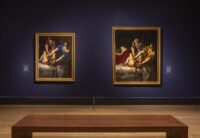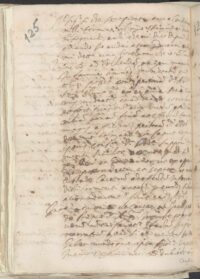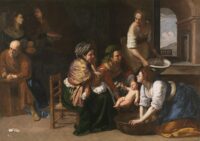 This year London’s National Gallery is putting on the first exhibition in the UK dedicated solely to Baroque master Artemisia Gentileschi. The exhibition has been postponed twice due to COVID and is currently shut down until December 2nd. With major showcases like this that rely on priceless artworks loaned from other collections, changing the dates requires an enormous amount of effort and forbearance, not to mention expense, and with in-person museum attendance in ashes right now, the National Gallery is offering a curator-led film tour of the exhibition on demand for £8.
This year London’s National Gallery is putting on the first exhibition in the UK dedicated solely to Baroque master Artemisia Gentileschi. The exhibition has been postponed twice due to COVID and is currently shut down until December 2nd. With major showcases like this that rely on priceless artworks loaned from other collections, changing the dates requires an enormous amount of effort and forbearance, not to mention expense, and with in-person museum attendance in ashes right now, the National Gallery is offering a curator-led film tour of the exhibition on demand for £8.
It’s an idea with possibilities, even under non-pandemic circumstances, and I was curious to see whether it was worth the price of admission, so I booked a ticket. You do you have to create an account on the National Gallery website first ; name, email, phone number and address are all required. You are allowed a single “booking,” which will grant your account access to the film tour for 48 hours. The film can only be viewed on the National Gallery website. To watch, click your email address in the upper right of the screen, and select “online films” from the menu listing under “My account” on the left. Click the Watch Now button to view.
The movie is hosted by Letizia Treves, the museum’s curator of Later Italian, Spanish and French 17th-century Paintings. She walks through the galleries, starting with works from Artemisia’s early years in Rome. Treves gives a brief biography of Artemisia and introduces the viewer to the artist’s first signed work, Susannah and the Elders, painted when she was 17 years  old. Treves then relays how Artemisia was raped by her father’s colleague Agostino Tassi and how we know every detail of the ensuing trial because the original transcripts have survived. That transcript is on display in this gallery, loaned out for the first time by the State Archive in Rome.
old. Treves then relays how Artemisia was raped by her father’s colleague Agostino Tassi and how we know every detail of the ensuing trial because the original transcripts have survived. That transcript is on display in this gallery, loaned out for the first time by the State Archive in Rome.
Treves continues a chronological narration of Artemisia’s life and moves to the next gallery featuring works from her time in Florence. She painted some of her most famous pieces during this time, including two versions of Judith Beheading Holofernes, which Treves focuses on in her explanation. She then moves to the other side of the room and a series of self-portraits.
Artemisia achieved fame and success as an artist in Florence, enough that she became both author and subject of commissioned portraits when she returned to Rome. In the next gallery is a portrait of her done by another artist and portraits she made of noble subjects, but the real get are letters she wrote to her lover, rediscovered in 2011 in the Archivio Frescobaldi and on display here for the first time. Treves doesn’t read any of them verbatim, sadly, but she does summarize a few intriguing passages.
The next gallery features works from Artemisia’s artistic peak, paintings of Biblical and Classical motifs with women protagonists — Judith, Susannah, Mary Magdalene, Lucretia — done in dramatic light to satisfy buyers’ tastes for Caravaggismo. The works shift in scale and subject in the next gallery, following her move to Naples. Then under Spanish rule, Naples offered Artemisia a wide international pool of patrons, and it’s here that she painted her first monumental altarpieces. These were also her first collaborative works.
 Except for a brief stay in London, she would live in Naples until her death, expanding her repertoire to literary subjects and allegories. The next gallery features a monumental Birth of St. John the Baptist she painted for the King of Spain and her last documented painting, a Susannah and the Elders. The final gallery in the show presents paintings she and her father Orazio, who were reunited in London, made in the closing years of their careers. One allegory, a personification of painting, that is likely a self-portrait is the only work documented to have been painted when she was in London.
Except for a brief stay in London, she would live in Naples until her death, expanding her repertoire to literary subjects and allegories. The next gallery features a monumental Birth of St. John the Baptist she painted for the King of Spain and her last documented painting, a Susannah and the Elders. The final gallery in the show presents paintings she and her father Orazio, who were reunited in London, made in the closing years of their careers. One allegory, a personification of painting, that is likely a self-portrait is the only work documented to have been painted when she was in London.
Once the walkthrough of the exhibition’s galleries is concluded, Trevers takes a closer look at a few highlight pieces: the earliest Susannah, Judith sawing Holofernes’ head off in gore aplenty, Judith and her maidservant with the head of Holofernes in a basket, a later Susannah and the Birth of St John the Baptist.
So was the film worth the price of admission? It was interesting and a nice overview of an exhibition I’ll never get to see, but it was a little sparse for my taste. It’s short at just under half an hour, and it felt like Trevers was in a rush (which she was). Also, there was a missed opportunity here to mix media. In my ideal guided tour, there would be links that allow you to explore gigapixel images of the works themselves, plus transcripts and translations of the documents.
No regrets whatsoever, though. Museums have been brutalized this year, and I’ll gladly pay 10 bucks for content. They generate so much of it for free, it’s the very, VERY least I could do.
Workshops like Lucas Cranach the Elder’s produced Judiths in their dozens, some masterpieces, some maybe not, and some tiny miniatures.
All of them feature her and the ancillae in fancy clothing with the sword and the separated head, but unlike Artemisia, not the serene focus on the separation business itself:
upload.wikimedia.org/wikipedia/commons/a/a9/Judith_mit_dem_Haupt_des_Holofernes.jpg
upload.wikimedia.org/wikipedia/commons/4/4e/Lucas-cranach-judith-drawing.jpg
upload.wikimedia.org/wikipedia/commons/a/a0/Cranach_Judith_SammlRau.JPG